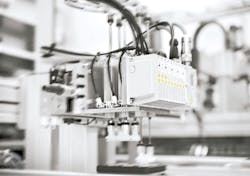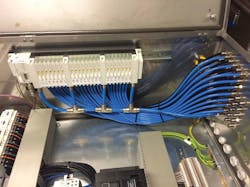This file type includes high resolution graphics and schematics when applicable.
Pneumatics is widely used in many packaging machines to drive motion and actuate machine sequences. It is a clean, reliable, compact, and lightweight technology that provides a cost-effective solution to help packaging machine designers create innovative systems, all the while staying competitive.
Manifold-valve technology plays a central role in the performance and effectiveness of pneumatic systems. Recent developments in this technology have increased their flexibility, modularity, and ability to integrate with—and be controlled by—the advanced communication bus architectures that are preferred by leading packaging-machine OEMs and end users, enhancing the application value afforded by pneumatics technology.
Pneumatics-Driven Packaging Applications
Pneumatics can be particularly effective for any kind of machine motion that combines or includes high-speed, point-to-point movement of the types of products with the weight and size dimensions typically found in packaging machines. This includes indexing, sorting, and pick-and-place functions. It is also used for suction cups or non-contact transfer devices.
For example, pneumatics can drive multiple functions on cartoning machines: indexing the infeed of blank cartons onto the process line; driving machine components that help form the folds; closing those folds; and moving glue guns or other sealing devices. In form fill and seal machines, it’s common to have pneumatics drive clamping devices and heat sealers, as well as tension controllers on rollers discharging the plastic film that forms the bags being sealed.
Several factors continue to make pneumatics broadly appealing to machine builders in the packaging industry. One is cost of ownership: Not only are most pneumatics components relatively low cost to begin with, the systems themselves are relatively easy to maintain and repair. They do not require special training or outside specialists, which can add to operating costs.
Pneumatic-driven systems move products through machine sequences at high speeds—typical systems support motion sequences of up to 5 m/sec, and higher-end cylinders support 11 m/sec. These rates satisfy a significant percentage of throughput rates found in many packaging-machine applications, such as pick-and-place systems.
Pneumatics technology is easy to integrate into larger machine designs; it is highly modular, lightweight, and compact enough to be installed on moving machine elements such as linear modules. It also offers the kind of long-lasting reliability expected from today’s automation technologies. For example, one pneumatics supplier’s valve series has been tested to operate through 140 million duty cycles without device failure.
Manifold Valves Control the Flow
All pneumatics systems work on the same basic principle: A single air source provides all of the air pressure needed for the different components, and it is the valve system that controls the distribution and sequencing of the air to drive individual actuators.
Standard valve systems typically provide directional flow control: Air is supplied through one valve to actuate a pneumatic cylinder and drive the motion cycle on a machine device, and the air is released through the manifold following a different path. Most packaging machines use 12-15 station valve manifolds, but more advanced designs are available that support up to 64 valve stations.
Another common valve configuration is a 3/2 (three-port, two-position) valve, which supplies air to extend a cylinder, and then shifts to allow the cylinder to retract. This type of valve configuration can be a more compact design, since some manufacturers allow two 3/2 valves to be paired in one valve slice for greater flexibility in controlling motion sequences.
A newer capability now being offered with pneumatic valves is pressure control. Typically, the manifold supplies the same pressure to all actuators. Manifolds can be supplied with individual pressure regulators for each work port. Newer technology allows for electronic pressure control for a single output or downstream air pressure in the manifold. Certain packaging applications, such as a clamp that is grasping and holding a product, may demand less pressure to handle a sensitive item properly without damaging it.
Key Valve Design Considerations
When selecting a valve system, the main criteria to use are the valve’s flow rate, the weight and space constraints associated with fitting it into a machine design, and the valve’s functionality.
Significant design advances have made valves more compact and modular. This includes the expanded use of high-grade polymers to reduce valve weight. Lightweight construction is key to keeping the valve as close to the actuators it is controlling as possible.
Minimizing the distance from the valve to the components helps reduce installation and connection costs. More importantly, it improves overall pneumatic energy efficiency. Air is considered an expensive commodity in many operations; if you can mount a compact, lightweight manifold close to the cylinders it is driving—even mounting it on the end effector itself—the lighter weight enables the machine designer to use smaller actuators that are moving that end effector. Lighter weight plus smaller cylinders add up to less energy needed to supply the requisite pneumatic flow.
Other innovations have also made pneumatic valves more compact and easy to locate within crowded machine spaces or control cabinets. One design uses a diagonal “wedge” shape that positions the pilot section over the top of and on one side of the valve, and the air output on the other side. This approach is up to 45% more compact than other designs and provides higher air flow than valves of comparable design.
Another valve feature to assess is spool design. The spool is the moving device within the valve that regulates airflow. Some valves use a metal spool designed to fit into a honed housing. Others use more lightweight polymer housing with a metal spool and O-ring seals on the body of the spool, or the spool housing, to provide a seal and prevent leakage. Each design has its advantages: Seals can wear out and have to be replaced. However, they do reduce leakage and provide better airflow.
Making Valves Smarter
As with many other developments in packaging automation, demand has increased for pneumatics technologies to provide more sophisticated control and integration of digital intelligence and communications capabilities into their architecture.
When considering a pneumatics platform for a packaging system, it is critical to determine the level of control sophistication the system needs, which will help machine designers and end users select the optimum configuration. Leading pneumatics suppliers are engineering high-throughput, multi-protocol bus-interface modules that make it much easier to integrate valve manifolds into PLC systems.
Machine builders can select from modules that support most major communications protocols used in the packaging industry, including Profibus DP, DeviceNet, and Ethernet/IP. This single serial bus connection replaces older, more costly, time-consuming methods that require each valve on a manifold to have a standalone communications link with the machine controller.
There is also a trend to integrate I/O connections into these bus modules. This provides a further cost savings: Many pneumatics-driven actuators also have sensors capturing motion data from the pneumatic cylinder via I/O links. By integrating multiple I/O ports into the valve communications bus module, machine builders can eliminate the need for separate I/O bus modules.
Emerging Trends
Valve designers are investing in new functionality, leveraging the capabilities available from the advanced digital bus modules that are being added to manifold valve systems. For example, many machine designers want to be able to do condition monitoring and conduct diagnostics on valve components using feedback loops similar to those used in electric drive systems.
In the near future, it will be possible to monitor the actual position of the spool within each valve on a manifold. By actually monitoring the spool position, the machine can track exactly how each valve performed during a motion cycle—where that valve started, whether it fully or only partially shifted, and its final position. This data helps machine builders and end-user operators isolate and correct issues that may affect overall packaging quality and integrity.
A newer capability now being offered with pneumatic valves is pressure control. Typically, the manifold supplies the same pressure to all actuators. Certain packaging applications, such as a clamp that is grasping and holding a product, may demand less pressure to handle a sensitive item properly and not damage it.
Using the digital bus interface, the machine controller can adjust the pressure on an individual valve or series of valves that drive that actuator. This allows one manifold to be used, rather than multiple valves with different pressure ratings.
One more emerging capability is built-in safety functionality. There are valve manufacturers considering adding Category 3 and 4 exhaust valves to the manifold. Instead of exhausting the air from allof the actuators controlled by the valve in the event of emergency machine shutdown, it can be done selectively. In the event that certain actuators are holding a load when the machine comes to a standstill, those actuators remain pressurized while other axes on the machine are safely exhausted.
Sustaining Pneumatics Value
Pneumatic-valve systems continue to advance, with investments in technology making them more versatile and intelligent in response to the evolving demands of the packaging-machine marketplace. Abroad range of manifold valve options are available; by considering those engineered to provide compact, lightweight design and use of digital electronics for easy integration into automation controls platforms, packaging-machine builders and end users can be assured that their solutions deliver maximum commercial value.
Erl Campbell, Industry Segment Manager
This file type includes high resolution graphics and schematics when applicable.
About the Author

Leaders relevant to this article:






